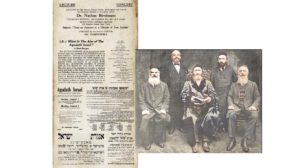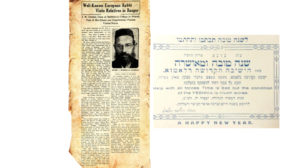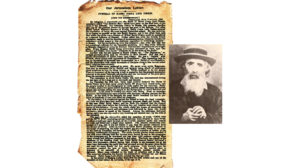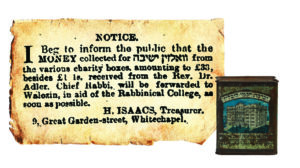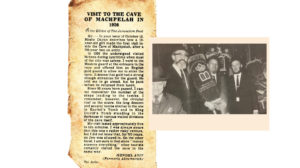Run, Dov, Run
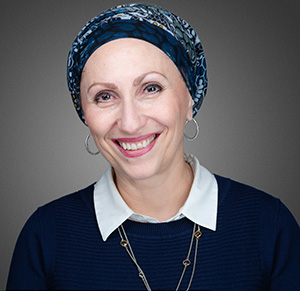
He was a regular guy from Brooklyn on his way to work. One snap made him a familiar face to millions
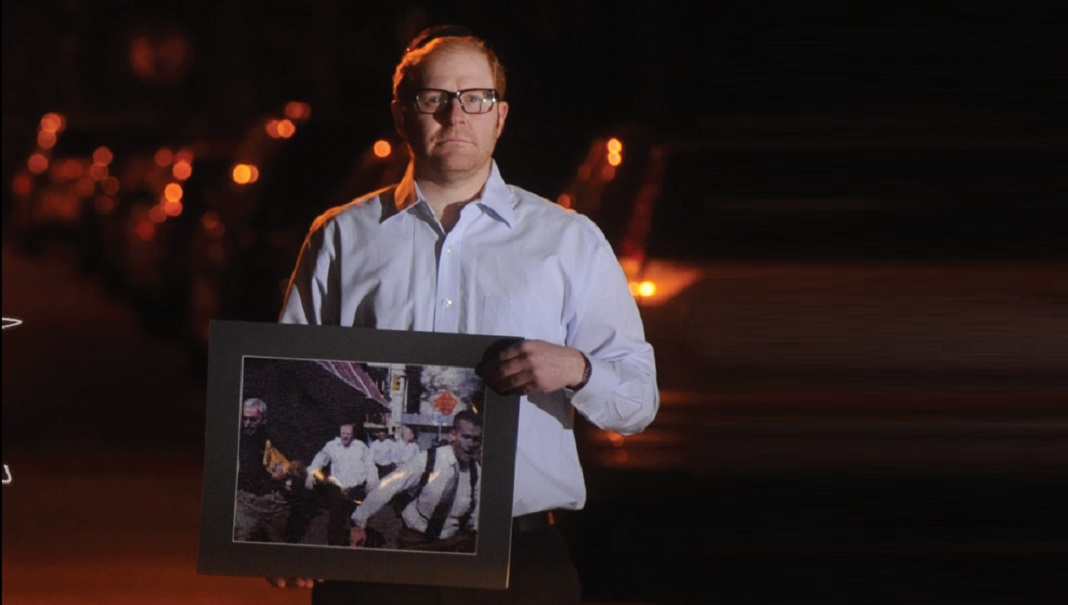
"I
’d gone to Selichos, and I was late getting back from shul,” he says. Still single and in his middle 20s, he was living with his parents in their Bedford Avenue home. A typical yeshivah grad from Flatbush, Dovy had attended Toras Emes, Yeshiva of South Shore and Merkaz HaTorah before completing an accounting degree at Brooklyn College. After that, he took a job working for the Commodities Exchange at the New York Board of Trade, on the eighth fl oor of the World Trade Center. This was high stakes, high-adrenaline work.
“There were 18 different rings, each dealing with a different commodity,” Dov explains. “You know those guys on the trading floor who are jumping up and screaming? That was me. I’d always wanted to do that.”
Dov had a seat on the exchange and was in the coffee pit. He’d been there since 1997 and loved his job, despite the fact that he doesn’t drink coffee and was the only frum person in that particular ring. Given the breakneck speed of the bidding and limited time slot of four hours, it was crucial that he be there every morning before the bell went off at 8:45.
A
ll Dov Blumenthal could think about on that sunny fall morning of September 11, 2001, was that he was going to be late for work. That morning, he jumped on a Q train and made his usual switch to an N or R. Those lines usually took him directly to the World Trade Center — all he had to do was hop on an elevator right there in the station to get to his job in the North Tower.
But then he heard the conductor make some unintelligible announcement, and the train sailed past World Trade to the following stop at Rector Street. He couldn’t have known that at 8:46 a.m., hijacked American Airlines Flight 11 had just crashed into the North Tower between floors 93 and 99.
By now Dov was really uptight; missing his stop meant he surely already missed the opening bell. He sprinted up the steps out of the train station. When he emerged, the sky looked so looked so dark he thought it must be raining. As he reached a corner across from the World Trade Center, he heard a huge bang. Crossing the street, he saw chaos: thousands of people running in panic. “I looked up, and I saw this huge fireball atop the building,” he says. “I was about ten feet from the door I’d normally use to go in, but I couldn’t get in because everyone else was running out.” It was 9:03. United Airlines flight 175 had just crashed into the South Tower. “I had no idea what was happening. I was standing there watching the upper floors burn, but I figured they’d just put out the fire and we’d all go to work later. Then I happened to glance at my phone, and I saw I had maybe 45 missed calls.”
When he tried to call back, he found he couldn’t: his phone had mysteriously stopped working. He walked over to Broadway, where a dozen people were waiting in line for a payphone, watching the fire and exchanging scraps of information. As he stood in line waiting to call his parents and reassure them he was fine, everyone suddenly ran away. Then he spotted a suitcase next to the phone and a cop looking at him.
“He didn’t let me make that call. You know, they saw an abandoned suitcase and assumed it was terrorism.” He continued to the corner, when he suddenly heard another tremendous bang.
“I looked up and saw the tower — it looked like it was splitting from the bottom up,” he says. “It looked like the windows were popping out of their frames one after the other, all the way up. I never heard anyone else describe it like that, but I was standing very close to the bottom. I saw the top of the tower leaning a little forward, and I thought, ‘Oh, no, that’s not good.’ I thought it would come falling down onto the city — it would crash onto block after block of city. In a way, it’s really a chesed that it imploded from the inside.”
He also saw objects falling, assuming they were desks or office equipment being thrown out of windows. It was only later that he realized they were people jumping.
It was 9:59. The South Tower had just imploded, 56 minutes after impact. Suddenly he felt the ground begin to shake like an earthquake, and saw a cloud rising and rumbling from the area of the towers. The cloud started pouring down the street, coming closer and closer, .
“The cloud looked totally solid and dark, like a concrete wall that was going to run us over,” Dovy remembers. He turned around and began running — he’d gone about five steps when he happened to notice a lady in an Associated Press jacket taking pictures. Another dozen or so steps, and he turned around and saw the cloud just a couple of feet behind him. Then it caught up with him, knocking him down.
In a way, it was a relief to find the cloud wasn’t the massive wall it appeared to be. He saw other people tripping and falling. His mouth had filled with pebbles and grit, and now he took off his shirt and held it over his head to avoid taking more in.
He got up and continued running, trying not to inhale too much. He remained stuck in the cloud for a few more blocks, but then noticed a kind of wind tunnel off to his left where the air looked clear. He followed it, and eventually managed to make his way to the Williamsburg Bridge. Once he was on the bridge, his phone vibrated, indicating it had resuscitated; he was able to call his frantic parents.
About 40 chassidim had stationed themselves on the Brooklyn side. They’d set up tables with thousands of water bottles that they were distributing to the parched, footsore, dazed refugees.
“What a kiddush Hashem that was,” Dovy comments. “One of them saw my ash-covered yarmulke and asked me if I was okay. I hadn’t even realized I was covered in soot. He invited me back to his home, and my parents picked me up from there.”
A
s Dovy fled the collapsing towers, he had but an instant to notice Suzanne Plunkett, the Associated Press photographer snapping pictures. Plunkett, then 32 and originally from Minnesota, had been sound asleep when the first tower was hit. She wasn’t scheduled to work that day until the evening, at a DKNY show for Fashion Week. In fact, she was annoyed when the vibrations of her pager startled her out of her sleep, telling her Call immediately, 911. (In those days, 911 still meant “emergency” instead of an infamous date in history.)
She felt even more annoyed when she tried calling her bosses and got only busy signals over and over. Then she turned on the television to catch the weather report....
Seconds later, she saw the second plane crash into the WTC. She grabbed her equipment and headed out, more excited than worried, more concerned about having forgotten to bring her lunch. Plunkett emerged from the train station just seconds before the second tower fell.
“It was like one of those terrible nightmares where you’re running and you’re in quicksand or something and you can’t run away,” she told the Uptown Chronicle a week later.
Like Lot’s wife, however, she couldn’t resist the pull of turning to watch destruction rain down in clouds of sulfur and rubble: “I was running as fast as I could, but then I stopped and I had to look. I had to take pictures,” she said.
She made her way to an open deli, where she borrowed the phone line to connect her computer and upload pictures. Her editors were clearly taken by what she had to offer: that same day, the picture she took of Dov and others fleeing from the cloud became the lead picture for every AOL site. Then it would be featured in innumerable print publications. Plunkett had even managed to get a short video clip of Dov and the others running, which played later on CNN.
For Plunkett, being in the right place at the right time — and having the presence of mind to take a lot of pictures before she had to start running for her life like everybody else — garnered her new levels of recognition in her field. She has since married and moved to London, where she now works for Reuters.
D
ov Blumenthal sees himself pretty much as an ordinary frum guy from Brooklyn. “Why would you want to write about me?” he asked Mishpacha, in genuine confusion. “I just happened to be there at the same time as a photographer.”
He does make a good Everyman; aside from his bright orange hair, he’s medium height, affable, a working man with a steady, solid presence. Perhaps that’s why in the photo he blends so well into that throng of stampeding people fleeing the threatening cloud billowing behind them.
But it’s not always up to us to decide how we will figure into history, nor do we always have the option of acquiescing before finding ourselves on the front pages of major media outlets. Ready or not, Dov found himself famous as soon as Plunkett’s photos reached the media.
“Back in 2001 AOL was still one of the biggest Internet providers and mail services,” he reminds us — and they’d grabbed Plunkett’s photo for their lead picture. So when all his friends and family opened up their computers that day, the first thing they saw was that photo splashed over the screen.
“I got about a million phone calls that day,” he says. “But I figured, ‘Okay, that’s just AOL, and it’s just the first day. By tomorrow it’ll be picture number 18 and all the flak will die down.”
What he hadn’t anticipated was that all the news weeklies — Time, Newsweek, Business Week, US News and World Report, weekend editions of the New York Times and other newspapers — would appear with his picture just a few days later. People all over were recognizing him — “between my orange hair and my yarmulke, they couldn’t miss me.”
For the next year people often stopped him on the train, and more than a decade later, people occasionally still recognize him from the picture. Dovy says he also became that much more aware of the significance of wearing a yarmulke.
“People really notice it,” he says. “You have to be aware of how you behave, because people do remember.” But Dov has no illusions about the value of this sort of flash-in-the-pan fame. “I would’ve rather become famous for a different reason,” he admits.
But there was one bonus: When he became engaged to Bluma two years later, her relatives in London and Antwerp didn’t have to wait for formal photos from the vort to get a glimpse of her chassan: she just sent them the link to his 9/11 photo online.
W
hile it was providence that saved Dovy’s life, for two of his colleagues, the timing had tragic consequences; two workers from the eighth floor perished.
“When the first plane hit and they all saw pieces of the plane on the ground, most of the people left,” he says. “But one of the guys in the next ring was meeting a client, and he’d told him, ‘Let’s go to breakfast up at the top.’ The irony is that it was the first time he’d ever gone to the top.”
As for the client, he was a first-time visitor to New York. His flight had come in from Hong Kong that morning. After 9/11, the Commodities Exchange moved temporarily to a property they owned in Long Island City, and was eventually bought out by Intercontinental Exchange (ICE).
“The trading all moved online,” Dov says. When the excitement left the trading floor, he left too. Now he does construction and real estate, renovating houses and flipping them; his wife Bluma, who has a degree in nursing, works in the nearby Beth Israel ER. They bought a house on a young, congenial block in Marine Park, and Dov, never having sought fame in the first place, is more than happy to stay out of the limelight. Nevertheless, Bluma took the 9/11 photo and had it blown up, as a gift, with a special software that composes the image out of tiny blocks of newspaper pages.
Occasionally their children, who range in age from eight to two, clamor for the story of that picture. So far, Bluma just answers, “I’ll tell you about it when you’re a little older.”
Originally featured in 'Flashes in Time' Special Supplement, Pesach 5773
Oops! We could not locate your form.

